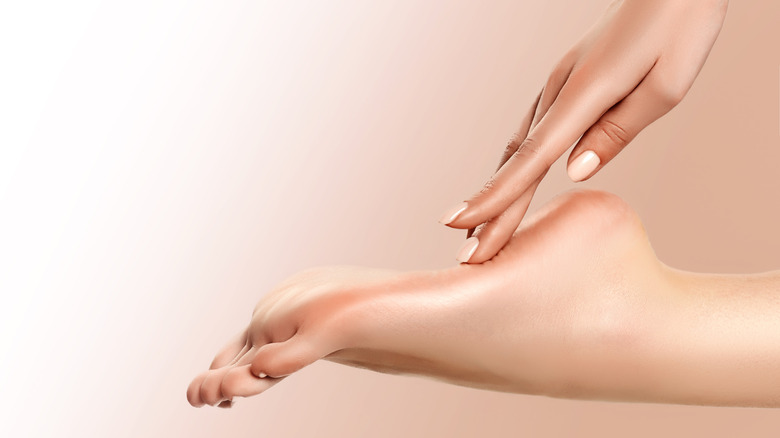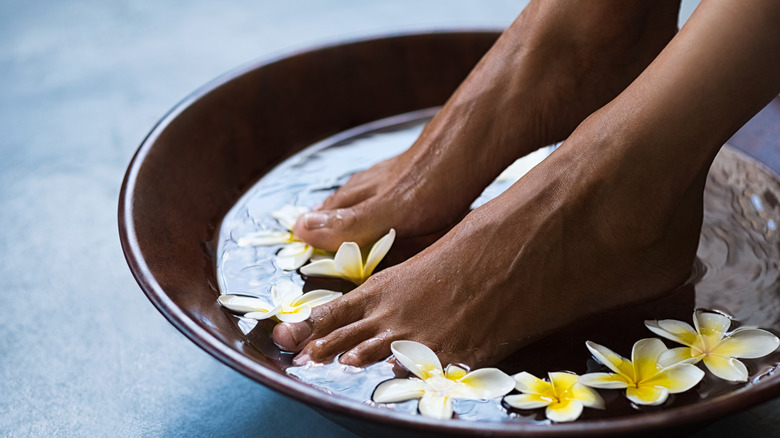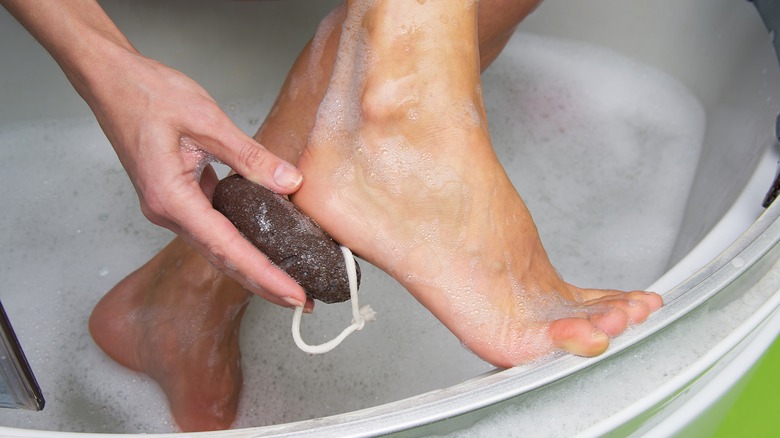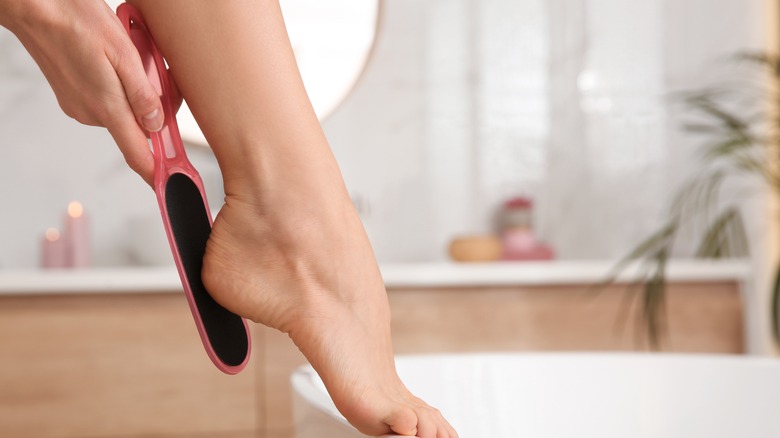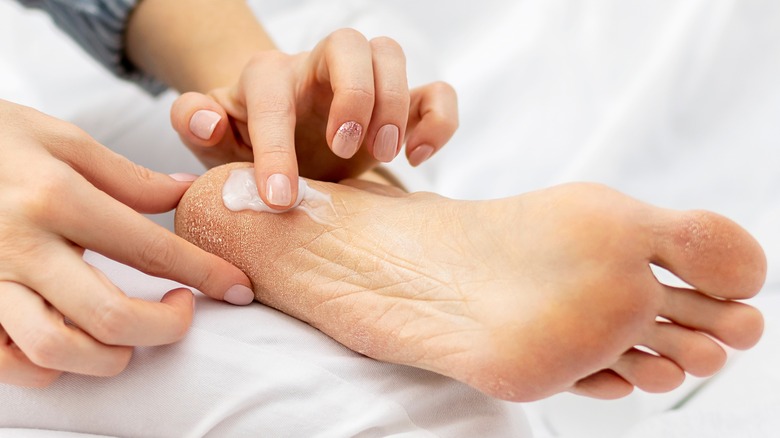Your Guide To Getting Baby Soft Feet
On a daily basis, our feet are on the receiving end of seemingly harmless activities like walking, running, dancing, and wearing open-heeled shoes. According to a 2014 poll by the American Podiatric Medical Association (APMA), eight out of 10 Americans have dealt with foot issues, which can range from an ingrown toenail to persistent foot discomfort. Excessive wear and tear is the number one reason why our feet are highly prone to calluses and corns.
Aging also plays into the gradual dehydration of your feet, causing your feet' skin to look dry and flaky. Over time, the sweat glands in the feet lose their activeness and make the skin look dry, so we need to be warier of our hydration levels as we get older, podiatrist Margaret Dabbs tells The Guardian. "To help prevent and treat common foot complaints, good home care is necessary," she emphasizes. With the right tools and products, our feet can regain their softness and flexibility in no time. While a trip to the salon for a pampering pedicure treatment is a good way to kickstart your foot care routine, there are numerous techniques you can try at home to get baby-soft feet.
1. Have a foot soak daily
A relaxing foot soak in warm water is a tried-and-true method to soften dry skin, Medical News Today points out. Plus, soaking your feet in warm water for about 10 minutes can relieve sore muscles and give you a good night's sleep. To prepare for a foot soak, FixingFeet Institute recommends filling a basin two-thirds full with warm water. Then, add one cup of Epsom salt to the water and swirl, either with your hand or a large spoon, until the salts are dissolved.
Containing magnesium and sulfate, Epsom salt is able to take the edge off the skin, prevent blood clots, and stave off bacteria. Or, you can replace Epsom salt with apple cider vinegar, which also has the power to make the skin soft and supple. The alpha hydroxy acid inside apple cider vinegar is effective in removing dead skin cells to facilitate the growth of healthy new skin cells. If you also have a problem with foot odor, toss in one tablespoon of baking soda, followed by essential oils or herbs, for an extra dose of calming aroma. Then, soak your feet in the water for 20 minutes, and use a towel to pat them dry, especially the creases between your toes.
2. Exfoliate your feet to remove dead skin
The secret to revealing soft skin is to slough off dead skin cells. Dead skin cells should be removed from your feet frequently, if not daily, because as they build up, the skin becomes less elastic and sensitive. Before long, your skin will eventually become drier, thicker, and crack. To prevent heel cracks and get rid of foot corns and calluses, exfoliate them with a pumice stone daily, Healthline advises. A mixture of lava and water, a pumice stone is light yet abrasive enough to effectively and gently remove thickened patches on your feet to expose softer skin, per dermatologist Caroline A. Chang (via Prevention).
Before exfoliating with a pumice stone, soak your feet as well as the stone in warm water for about 5 to 10 minutes. When a pumice stone is wet, it will skate on your skin more smoothly, minimizing the risk of injury. Once both your feet and the pumice stone are already wet, lightly rub the abrasive side of the stone against your skin in a circular motion. Then, massage your skin, with a focus on your toes and your heels, for two or three minutes. Keep repeating the motion until patches of dead skin are no longer in sight, and then give your feet a good rinse. You can exercise this habit daily or a few times a week, but remember to cleanse your pumice stone after every session to keep it clean.
3. File the rough area of your feet
Using a foot file on thickened or calloused feet after a shower is also a good way to slough off old and dead skin and keep infection at bay, says dermatologist Sheel Desai Solomon to NBC News. She also recommends using a foot file that doesn't have sharp teeth to avoid scraping or cutting yourself. Meanwhile, celebrity podiatrist Margaret Dabbs (via Women's Health) recommends filing your feet when they are dry and not wet because wet skin masks the areas that need to be addressed. Also, if you file with imprecision, you can over file and weaken the skin tissues, which makes your skin more vulnerable to infection.
Once your feet are completely clean and dry, grab a foot file and apply gentle pressure on the areas laced with thickened or calloused skin. Then, lightly file towards the midline of the foot and steer clear of irritated skin or open sores. For optimum results, use a foot file in conjunction with an exfoliating foot scrub once to twice per week. Then, follow up with a foot cream specifically designed for calluses to stop them from re-emerging.
4. Moisturize your feet
Your feet don't produce oil, meaning they can't hydrate themselves. Therefore, moisturizing them every day with lotion, cream, or petroleum jelly is an indispensable part of a basic foot care routine, per WebMD. Keeping your feet hydrated can prevent hard pressure points and minimize the risk of cracked heels. The only place where you shouldn't put moisturizer on is between your toes because they need to be kept dry to be safe from bacteria and fungus. The best time to moisturize your feet is after you get out of a shower or have exfoliated your feet.
According to Podoactiva, your feet should be moisturized at night as opposed to in the morning. The reason being is if we moisturize our feet in the morning and then place them inside a pair of shoes, the combination of hydration and perspiration results in "maceration," a situation where your skin is exposed to moisture for too long. A moist and closed environment can take a toll on the feet. Aside from using a moisturizer, you can soften and hydrate your hard-working feet using a rejuvenating foot mask every once in a while. You can either buy ready-made foot masks or make a DIY mask using nourishing, fool-proof ingredients like yogurt, olive oil, or brown sugar.
5. Drink lots of water
Moisturizing your feet might help with skin dehydration, but drinking lots of water is what helps your skin get hydrated from the inside out in the long run. Therefore, consume an amount of water that equals half your body weight in ounces per day if you want feet that burst of healthiness. "I encourage my patients to hydrate by drinking plenty of water and eating water-rich foods such as cucumbers and watermelons," podiatrist Dr. Miguel Cunha tells Byrdie.
Echoing this sentiment, Dr. Marco Setti, Head of Vascular Surgery at Humanitas Gavazzeni (via Humanitas University), notes that those who suffer from leg swelling don't drink enough water daily. Therefore, it's crucial to supply your body with adequate fluids by consuming lots of vegetables, fruits, as well as natural water. Another thing to keep in mind on your journey to retrieving healthy, hydrated feet is to not go overboard with the notion of "baby soft." In fact, your feet don't have to be as soft as babies' bottoms. Unlike your arms or your face, the skin of your feet still needs to be sufficiently thick to absorb stress and protect your feet from injuries.
